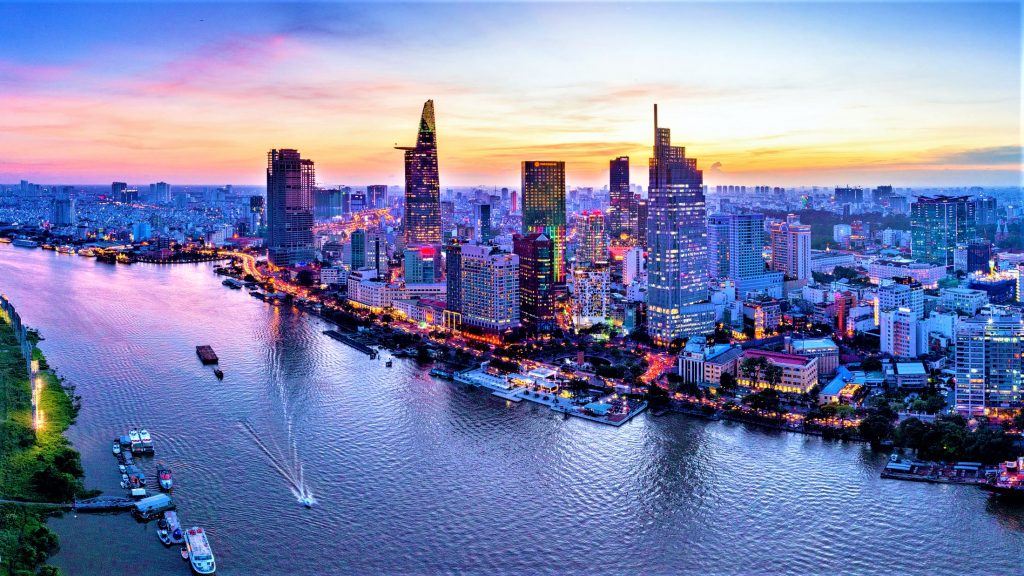How many days do you need to travel to Vietnam?

The duration of your trip will determine the most suitable route. For those with limited timed, we would like to suggest 8 – 11-day journey focus on the most emblematic points such as Hanoi, Halong Bay, Da Nang/Hoi An, Hue and Ho Chi Minh City.
Major areas and cities include:
The North: With Hanoi, the capital, and the stunning Halong Bay. We recommend spending 2-3 nights in Hanoi to enjoy its vibrant atmosphere and rich cultural heritage. In Halong Bay, a night aboard a traditional sailboat is the best way to enjoy this paradise.
The Center: Hue and Hoi An are a must. Hue, with its strong Chinese influence, is worth a 1-2-night stay. Hoi An, with its coastal and traditional charm, is also ideal for 1-2 nights.
The South: Ho Chi Minh City (formerly Saigon) offers a unique energy that you can enjoy in 2 nights.
Ha Noi

A city of lakes, parks and colonial mansions, Ha Noi retains much of its historical charm and, with an eclectic mix of Asian tempo and French refinement, Vietnam’s capital is a city to be savored.
Unlike the typical tropical conditions of South Vietnam, the capital of Vietnam shares the north’s mild tropical climate, with cold winters from November to February and a monsoon season that reaches a rainy crescendo from June to August.
Ha Long Bay

Approximately 170 km from Ha Noi, the mystical landscapes of Ha Long Bay are one of Asia’s most iconic sights. Translated as the ‘Bay of Descending Dragons’ and located in the Gulf of Tonkin, Ha Long is made up by some 1,600 islands and islets, forming a spectacular seascape of limestone pillars, lush islands and emerald waters. Ha Long Bay is justifiably one of the world’s natural wonders and more than deserves its UNESCO World Heritage status.
The periods September – November and March – May are ideal for a trip to Halong Bay with dry climate and pleasant temperature.
Da Nang

One of the oldest settlements in Vietnam, Da Nang is now a city on the verge of modernity. The riverfront promenade has been spruced in recent years whilst the revamped airport now boasts international status. Da Nang Beach, on the other hand, is actually a series of beaches extending between Da Nang and the riverine town of Hoi An is home to several luxurious hotels and resorts, making the region an ideal base for exploring the nearby charms of Hoi An and the evocative Cham ruins at My Son.
The best time to visit Da Nang is from February to May when the rainfall is minimal, with mostly sunny skies and less humidity.
Hoi An

Hoi An Ancient Town is listed by UNESCO as a World Heritage Site and without doubt is one of the most attractive destinations in Vietnam with exceptionally well-preserved example of an important trading port which was active between the 15th and 19th centuries and its design reflects centuries of influences from both local and foreign residents.
The dry season is from February until July with warm temperatures (even hot during summer). It is lucky if you can travel to Hoi An on the 14th day of the lunar year each month when Hoi An celebrate the Full Moon Festivals and becomes the stage for traditional songs, dancing, games and special vegetarian versions of all the local specialty dishes, with lanterns lining all of the streets.

Hue
The capital of the Nguyen dynasty’s empire from 1802 until 1945, Hue was the religious, economic and cultural epicenter of Vietnam for more than a century. Situated on the banks of the romantically named Perfume River, the town of Hue is known as the Imperial City of Vietnam. Built by Emperor Gia Long in the early 1800s, the exquisite Forbidden Purple City remains extremely palatial and received UNESCO World Heritage status in 1993.
The most ideal time to visit Hue is between January and April, with a pleasant average temperature of 20°C to 24°C. Annual festivities such as the Tet and Hue Festival are also celebrated during this period.
Ho Chi Minh City

The most western of Vietnamese cities, Saigon, as it is still commonly known, is a city of contrasts; a place where ultra-modern shopping malls and fashionable restaurants vie for space with local retailers selling all manner of wares and quiet roadside cafes making delicious Vietnamese iced coffee (cafe sua da) and other liquid refreshments. With so much to see and do, an international dining scene and some of the most luxurious hotels in the country, Ho Chi Minh City is a truly remarkable destination waiting to be explored.
Actually, the city really only experiences two seasons: wet and dry. The annual northeast monsoon causes dry season to run from around November to April each year. Monsoon season begins with increasing rainfall in May that lasts until October.
If you’re looking for a more in-depth experience, you should consider adding some more destinations like Sapa in the north, famous for its rice paddies, or the Mekong Delta region in the south. Alternatively, please feel free to choose more destinations from “Valuable add-ons”
Then, let’s go the “The Complete Journey”
